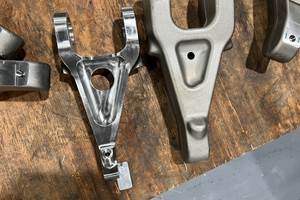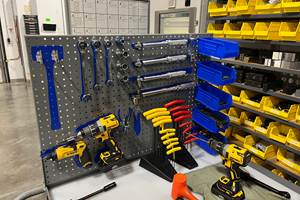Implementing A Machining Cell
A large horizontal machining center gives this laser manufacturer the capacity it needs for now as well as a growth path to meet future needs.
It's hard to imagine a manufacturer of lasers purchasing a giant 30-hp horizontal machining center with a 50-taper spindle and a rail-guided, vehicle-serviced stocker system. But that's just what Spectra-Physics Lasers Inc. did a few months ago at its Components & Accessories Group in Oroville, California, which is two hours north of Sacramento. And, that's just the beginning, because a second machine is on order and a third is being justified. In fact, the floor is based and marked for four machines, and a total of five could be handled in the current space.
Many might think of the laser industry as a high technology "cottage industry" filled with scientists and technicians machining and assembling strange and unusual componentry with little thought to the cost. That's far from the case, especially when it comes to Spectra-Physics, one of the leading laser manufacturers in the world. They serve both end-users of lasers in fields from scientific and medical to industrial and defense, as well as providing componentry to OEMs that incorporate lasers in their equipment.
The parts are highly complex prismatic workpieces with only the occasional requirement for contouring. Materials considerations run from about 80 percent aluminum to copper alloys and various high-alloy stainless steels, as well as Kovar and Inyar. Lots average about 25 to 50 parts, but lots of one are not unusual. What is usual is a very broad parts mix, more in keeping with a job-shop environment.
Cell That Grows
The machines at the heart of the new cell are Toyoda FA550 horizontals supported by the rail-guided vehicle and a three-tiered, 12-pallet stocker controlled by a touchscreen cell controller. The current machine has a 30-hp, 5,000 rpm geared head spindle. The machine on order, the newest model, will be equipped with a 12,000 rpm broad-range, direct-drive spindle and has feed rates to 1,181 ipm.
This second machine will be spotted directly next to the existing machine and will use the same rail-guided vehicle with an extension of the current 12-pallet stocker by an additional 12 pallet positions. So it will go with the third and fourth machines. However, should the company opt for a fifth machine, it would be placed opposite the last machine, as the rail-guided pallet transport is bi-directional.
It should be noted that this was not Spectra-Physics' first foray into flexible machining systems (FMS). Already in place are six-pallet, 90-tool linear-way-type horizontals with 40-taper spindles. According the Tom Torres, business unit manager at Components & Accessories Group, a number of criteria pointed to the configuration of the new cells.
First, the lighter, six-pallet machines were heavily used and approaching capacity. Second, because of the complexity of the part mix, the 120-tool magazine of the Toyoda FA550 was attractive (the second machine will feature a unique 240-tool twin magazine tool system). The stability and resultant accuracy of this model (weighing in at 15 tons) was also a consideration. Notes Tom Miles, manufacturing manager of the facility, "We typically hold 0.004- inch true position between two features, and 0.0005-inch perpendicularity between surfaces."
This kind of accuracy is required for the alignment of the electromechanical and optical components in many of Spectra-Physics' laser resonators and optical assemblies, which have a worldwide reputation for their stability and reliability.
Mr. Torres also stressed his com-pany's need for reliable operation of machines in automated cells. His 60 people currently fill two 10-hour shifts, Monday through Thursday, and two back-to-back 12-hour shifts, Friday through Sunday. The laser business, he says, is very strong and growing, and he needed machines he could count on at the heart of his automation. He also appreciated the virtues of the 50-taper spindle for the demanding applications that exist at his plant.
But, most important to Mr. Torres, was the willingness of the machine tool builder to act as technology partner for the long term--five years and beyond. Also, he knew he needed the machines quickly, as the laser market demand peaks at the end of the calendar year. He had his system in five weeks after the close of negotiations last spring. Even more surprising, from the day the cell was delivered by truck, it took only seven days to get it up and running prototypes, and nine days to run scheduled parts.
Agility
It should be noted that Spectra-Physics is highly sophisticated in the way it produces parts, subscribing heavily to just-in-time (JIT) manufacturing strategies. Part data comes to Oroville from Spectra-Physics' headquarters in Mountain View, California, 200 miles away on the San Francisco peninsula, over a dedicated line. At headquarters, part data is created via Unigraphics, AutoCAD and Pro/Engineer software. Data files arrive at Oroville in the IGES format, where the shop uses PC-based CIMTECH to create CNC programs, with CIMNET as its DNC pathway. The company uses CIMNET Folders Light at Toyoda for documentation, and REALTRAC shopfloor management software for overall cell management.
This gives the operation the ability to respond with great agility. For example, Bob Farrell cited a recent request from Mountain View for a rather complex part to be delivered in 24 hours. Halfway through processing the Unigraphics data from Mountain View, Farrell was informed that the part had been modified to include five additional holes. "We delivered the part on time," he says, "and really surprised the folks at Mountain View."
Managing A Cell
The manufacturing managers at Spectra-Physics' Oroville plant do indeed advise that an automated work-center does have to be managed and run differently than other types of stand-alone or multi-machine cell operations. For example, John Wiemers, the plant's FMS coordinator, has been given overall management responsibility for the new cell. Currently, he is personally serving as operator, with one helper for general duties such as deburring or small secondary metal cutting tasks that have not been assigned to the machine. The second shift, currently six to 14 hours, is run totally unmanned. The goal is to run 24 hours per day less maintenance, manning two out of every four shifts.
For those parts that are machined on a regular basis, the shop designed its own dedicated pallet fixtures. Mostly, however, the company purchases blank cubes (10 by 10 by 30 inches, 8 by 20 by 30 inches, 14 by 14 by 30 inches, and 5 by 8 by 10-inch risers) with ½-inch holes on a 2 by 2-inch grid. They use a ball lock system permitting the entire face to be removed, and Toolex vise towers.
Cycle times currently average between one and two hours per load. At this point, probing is used primarily for fixture alignment because, says Mr. Farrell, the CAM data relative to both the fixtures and the parts are so accurate. The company does plan fuller probing coupled with Toyoda's compensation package on its new FA550, but the main reason for this is not so much to verify accuracy as to record that accuracy for quality documentation required by customers.
In terms of tooling, after two months, Spectra-Physics had already dedicated 80 tools to the 120-tool magazine. Because of the subassembly nature of most of the parts, many are geometric drills and taps. "We tend to use long tools to maximize setup flexibility," says Mr. Farrell. "We have experienced negligible compromises in stability versus shorter tools, even with long counterbores."
Of course, many of the tool magazine sockets can be used for spares, especially convenient in unmanned operations. The machine tool's standard insulated spindle "senses" broken tools by calculating Z-axis travel to part contact against programmed values, and it automatically replaces the tool when a broken tool is sensed.
Another reason behind the choice of the new horizontals was the expansive work areas. The machining envelope is almost 12 cubic feet. Workpieces larger than the envelope can be accommodated because of the unobstructed splashguard design coupled with oversized doors and long spindle clearances. Mr. Miles points to a large resonator, 28 inches long and 5.25 inches square, which must now be processed on a vertical spindle machining center. "We've had no choice," he says, "but we've been plagued by chip problems. I'm anxious to get that on one of the new horizontals."
Ready To Compete
According to Mr. Torres, the cell is the culmination of a four-year JIT plan that was launched when the Components & Accessories Group moved from its 66,000-square-foot facility in Mountain View. This plant had employed 180 people and included sheet metal and plating operations. At the new Oroville facility, 60 employees produce three times the business in 20,000 square feet. "We didn't need to be a sheet metal or plating house," he says. "We get better service locally from outside vendors. What we have experienced here is the ability to attract and keep higher skilled and dedicated people."
Everybody has benefited, he points out. Customers receive high quality at a low cost, the employees have more responsibility and work in a pleasant environment, and the company is poised for even more profitable growth with the technology to meet the most rigorous competitive challenges.
Related Content
Horizontal High-Speed Machining Saves Hundreds of Work Hours
High-speed machining is the latest change at Blair-HSM South, helping this once old-fashioned shop improve productivity and morale while enabling new work.
Read MoreGrob Robot Cell Enables Long Periods of Unmanned Operation
The GRC-R12 robot cell features a pneumatic single- or double-gripper system, as well as a drawer feed system with six drawers.
Read MoreVolumetric Accuracy Is Key to Machining James Webb Telescope
To meet the extreme tolerance of the telescope’s beryllium mirrors, the manufacturer had to rely on stable horizontal machining centers with a high degree of consistency volumetric accuracy.
Read MoreTranslating a Prototyping Mindset to Production
The experimental mindset that benefited BDE Manufacturing Technologies as a prototype job shop has given it an adaptable edge as a production facility.
Read MoreRead Next
3 Mistakes That Cause CNC Programs to Fail
Despite enhancements to manufacturing technology, there are still issues today that can cause programs to fail. These failures can cause lost time, scrapped parts, damaged machines and even injured operators.
Read MoreThe Cut Scene: The Finer Details of Large-Format Machining
Small details and features can have an outsized impact on large parts, such as Barbco’s collapsible utility drill head.
Read More.jpg;maxWidth=970;quality=90)







.jpg;maxWidth=300;quality=90)





.png;maxWidth=300;quality=90)
.png;maxWidth=300;quality=90)















